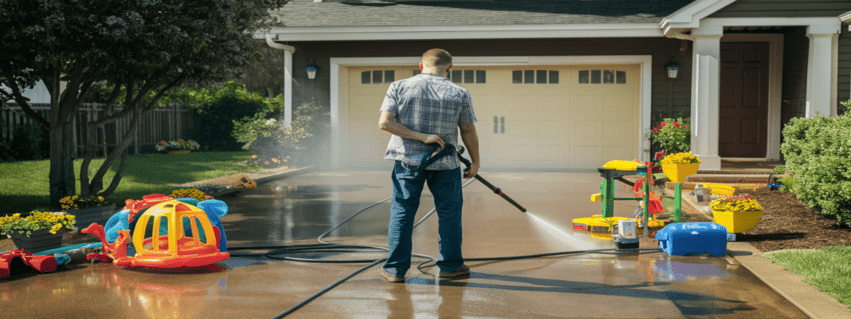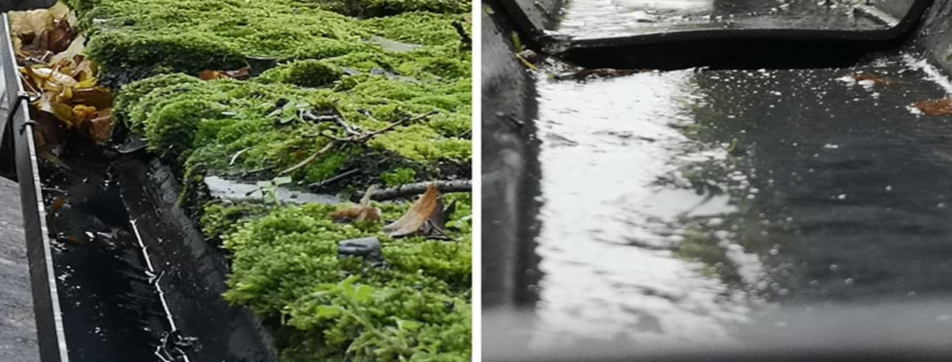How to Prepare Your Home for Pressure Washing
We all know that over time, patios, driveways, composite decking, and other exterior surfaces can attract a build-up of dirt and grime. Apart from your home not looking its best, these build-ups can contribute towards a danger zone and can cause irreversible damage to your property. This guide will help you prepare your home for a professional pressure washing service. By following these steps, you can make sure the clean you’ve been waiting for, runs as smoothly as possible. Key Takeaways Assess your home’s exterior to identify areas that need attention Check for loose or damaged materials that may require repair Clear the area around your home, removing outdoor furniture and decor Protect delicate surfaces, such as windows, plants, and landscaping Prepare your home for a thorough, safe, and effective pressure washing Assessing Your Home’s Exterior Take a close look at your home’s exterior, checking windows and framework, brickwork and render, and any other areas that may need additional attention before pressure washing takes place. Unsure if what you find is a concern? Let us know and we will be more than happy to help. Just remember, these careful check-ups help you get ready for pressure washing and can stop further damage. Identifying Areas That Need Attention Start by taking a look at your home exterior closely. Look for signs of wear and tear, damage, or loose parts that need fixing before washing. Focus on areas often hit by the weather, like the roof, gutters, trim etc. Don’t Risk Slippy Surfaces! Get a Free Pressure Washing Quote Today. Get Your Free Quote Now Checking for Loose or Damaged Materials While inspecting for damage to your home’s exterior, keep an eye out for loose or damaged parts. This includes cracked paint, missing siding, or loose trim. Spotting these problem areas early lets you protect them during washing. Doing a thorough home exterior assessment before pressure washing prepares you and ensures the cleaning runs smoothly. How to Prepare Your Home for Pressure Washing Getting your home ready for pressure washing is key to a safe and successful clean. By focusing on a few important areas, you can reduce the risk of damage. This ensures the best results for your home. First, clear the area around your home. Remove outdoor furniture, decorations, or other items that could get damaged. Keep these items in a safe place until the cleaning is done. Move all plant pots, children’s toys, gardening equipment, tables, chairs, and anything else that is in the area that you are having cleaned. Then, protect delicate surfaces on your home’s exterior. This includes windows, light fixtures, electrical outlets, and areas with cracked or damaged materials. Use tarps or plastic sheeting to cover these spots from the pressure washing. Look for any areas that need extra care. This might be stains, mildew, or tough buildup that needs pre-treatment or scrubbing before washing. Check for loose or damaged materials like cracked siding or missing roof tiles. Contact us to see if you need to fix these before pressure washing. Clear away leaves, twigs, or dirt that could be blown away by the high-pressure water and cause damage. Step Description 1. Clear the Area Remove outdoor furniture, decorations, and other items that could be damaged by pressure washing. 2. Protect Delicate Surfaces Cover windows, light fixtures, electrical outlets, and other vulnerable areas with protective coverings. 3. Identify Problem Areas Inspect for stains, mildew, or other issues that may require pre-treatment or additional attention. 4. Check for Damage Examine your home’s exterior for loose or damaged materials and make any necessary repairs. 5. Clear Debris Remove leaves, twigs, dirt, and other items that could be propelled by the pressure washing. By preparing your home for pressure washing, you ensure a safe and effective clean. This protects your property and reduces the risk of damage. Clearing the Area Around Your Home Getting your home ready for pressure washing is more than just moving a few things around. It’s vital to completely clear the area first for safety and efficiency. As mentioned, this means removing outdoor furniture, plants, and other items that could get damaged or block the way. This makes the area safe and easy for the pressure washing team to work and is key in preparing for the dream clean. Protecting Delicate Surfaces When pressure washing your home’s exterior, it’s key to protect delicate surfaces. This includes windows, doors, and landscaping that could get damaged by the high-pressure water. Make sure to cover or shield these areas to keep them safe. Here are some tips to protect delicate surfaces while pressure washing: Identify and cover all windows, doors, and other glass surfaces where necessary to prevent them from being scratched or shattered by the high-pressure water. Use tarpaulins or plastic sheeting to shield any landscaping, such as plants, shrubs, or flower beds, that could be damaged by the pressure washing. Protect any outdoor light fixtures, electrical outlets, or other sensitive areas by covering them with weatherproof materials. Ensure that any areas with loose or damaged materials, such as siding or trim, are properly secured or repaired before pressure washing. By following these steps, you can keep your home’s delicate surfaces safe. This helps ensure a successful and safe pressure-washing experience. Delicate Surface Recommended Protection Windows Cover with plastic sheeting or tarpaulin Doors Cover with plastic sheeting or tarpaulin Landscaping Cover with a tarpaulin or move plants/shrubs to a protected area Outdoor Lighting Cover with weatherproof materials Loose or Damaged Materials Repair or secure before pressure washing Conclusion Getting your home ready for pressure washing is key to a safe and effective clean. Start by checking your home’s exterior and clearing the area around it. First, look at your home’s exterior and see what needs extra care. Remove all outdoor furniture and decorations. It’s also vital to cover delicate surfaces like windows to protect them from the strong water pressure. By doing these steps, you’re setting your home up for a smooth pressure wash. FAQ What should I do before
How to Prepare Your Home for Pressure Washing Read More »


